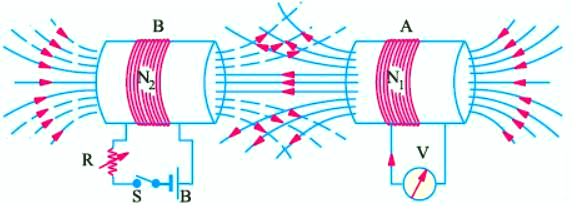Statically Induced E.M.F.
Statically Induced E.M.F. can be further sub-divided into
- Mutually induced e.m.f. and
- Self-induced e.m.f.
(a) Mutually-induced e.m.f. Consider two coils A and B lying close to each other (Figure given below). Coil A is joined to a battery, a switch and a variable resistance R whereas coil B is connected to a sensitive voltmeter V. When current through A is established by closing the switch, its magnetic field is set up which partly links with or threads through the coil B. As current through A is changed, the flux linked with B is also changed. Hence, mutually induced e.m.f. is produced in B whose magnitude is given by Faraday’s Laws (Article – Faraday’s Laws of Electromagnetic Induction) and direction by Lenz’s Law (Article – Lenz’s Law).
If, now, battery is connected to B and the voltmeter across A (Figure given below), then the situation is reversed and now a change of current in B will produce mutually-induced e.m.f. in A.
It is obvious that in the examples considered above, there is no movement of any conductor, the flux variations being brought about by variations in current strength only. Such an e.m.f. induced in one coil by the influence of the other coil is called (statically but) mutually induced e.m.f.

AdBlock-2
(b) Self-induced e.m.f. –
This is the e.m.f. induced in a coil due to the change of its own flux linked with it. If current through the coil (Figure given below) is changed, then the flux linked with its own turns will also change, which will produce in it what is called self-induced e.m.f.

The direction of this induced e.m.f. (Refer article – Lenz’s law) would be such as to oppose any change of flux which is, in fact, the very cause of its production. Hence, it is also known as the opposing or counter e.m.f. of self-induction.
Read article – Refer article – Lenz’s law
Visit NCERTplanet.com for NCERT solutions and Textbook downloads




